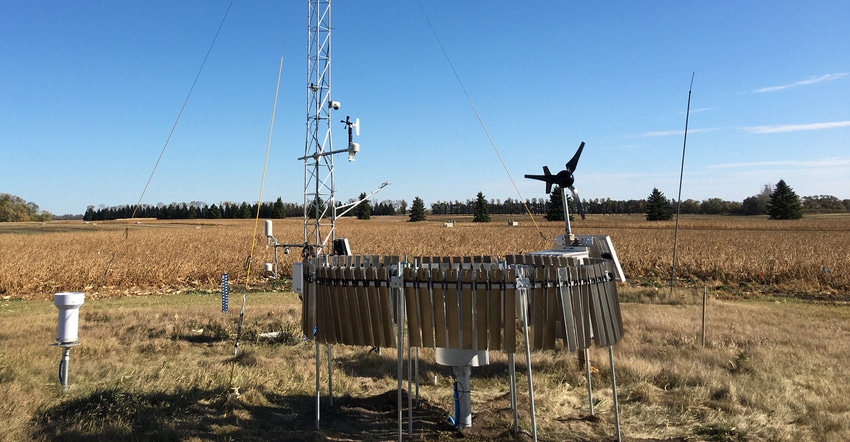
The U.S. Army Corps of Engineers has awarded five-year contracts to four Great Plains universities to upgrade or build new weather stations to monitor snowpack and soil moisture throughout the Upper Missouri River Basin.
The University of Montana will receive $21 million; North Dakota State University will receive $6.4 million; South Dakota State University will receive $12.8 million; and the University of Wyoming will receive $8 million.
Specific to North Dakota, funding will go toward the North Dakota Agricultural Weather Network, which monitors 159 stations distributed across North Dakota, western Minnesota and eastern Montana. NDAWN provides free online weather information.
“The one climate element that we have the least amount of data on is the moisture content in snow,” says Daryl Ritchison, NDAWN director. “Every storm, you will hear about the total depth from numerous sites, but it’s not the depth but the amount of water in the snow that is the most important in spring flood forecasts.”
One variable the network project will record is moisture content in every snowstorm.
In addition, Ritchison says total water inputs in the Upper Missouri River Basin would be monitored, not only precipitation but also soil moisture.
“These variables impact not only flooding, but also drought,” he says
New stations in North Dakota will be built where there are gaps in the NDAWN, Ritchison says. Gaps currently exist in the central part of the state, in Burleigh and Morton Counties.
The network updates are estimated to be completed by the summer of 2025.
NDAWN was established in 1989 and operates with major investment from numerous collaborators. Those include:
The High Plains Regional Climate Center, Lincoln, Neb., which provided the original grant launching the North Dakota weather station network. NDAWN continues to operate collaboratively with HPRCC for daily data handling and quality control support.
NDAWN station cooperators—county Extension and other cooperators for their voluntary contributions and assistance in keeping the stations operating year-round.
The Northern Plains Potato Growers Association (formerly known as the Red River Valley Potato Growers Association), East Grand Forks, Minn., for providing funds in 1991 to establish a station on the potato research farm near Grand Forks. Potato producers subsequently provided grants to purchase and operate five additional stations in the northern Red River Valley.
The University of North Dakota, for helping turn NDAWN into a statewide network by creating the Regional Weather Information Center and adding 16 stations in western North Dakota stations in the early 1990s.
Today, NDAWN data are used by the Bismarck and Grand Forks National Weather Service Offices to assist them in their forecasting mission, according to NDAWN.
Each NDAWN station is assumed to represent all weather conditions except rainfall within a 20-mile radius. The stations provide five-minute averages, hourly averages or totals for all variables, and hourly maximum wind speed. Each station also provides daily summaries consisting of maximum and minimum air temperature, maximum wind speed, times of occurrence and various totals or averages for all other variables. Data are sent via wireless modem to HPRCC.
While NDAWN weather data was specifically produced to aid farmers with future crop and pest management based on recent weather conditions, current information provided goes beyond agriculture.
NDAWN data are regularly used for a wide variety of purposes, such as government agencies citing its data to document weather conditions related to storm damage, accidents, crimes and regulatory violations. In addition, weather hobbyists, media, educators and students tap NDAWN data.
About the Author(s)
You May Also Like






